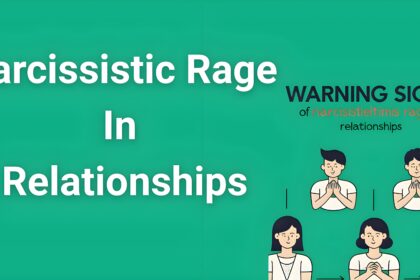What to do when a narcissist is mad at you? Do this now – if you're reading this while dealing with an enraged narcissist, you're in immediate danger and every action you take in the next few minutes could determine your safety and wellbeing. After working with thousands of survivors through NarcissismExposed.com as a Certified Narcissistic Abuse Specialist, I can tell you that narcissistic rage is one of the most dangerous and unpredictable situations you can face, requiring specific strategies that go against every instinct you have about conflict resolution.
- Emergency Protocol: What to Do When a Narcissist Is Mad at You Right Now
- Critical Mistakes: What NOT to Do When a Narcissist Is Mad at You
- Understanding Narcissistic Rage: Why Normal Strategies Fail
- Advanced De-escalation: What to Do When a Narcissist Is Mad at You and Escalating
- Emotional Protection: Shielding Yourself During What to Do When a Narcissist Is Mad at You Episodes
- Recovery Strategy: What to Do When a Narcissist Is Mad at You Aftermath
- Long-term Protection: Preventing Future Episodes
- Professional Help: When to Seek Emergency Support
- Key Takeaways: What to Do When a Narcissist Is Mad at You
- Frequently Asked Questions
The most important thing to understand is that narcissistic rage is not normal anger – it's a psychological eruption that can escalate to dangerous levels without warning, and traditional conflict resolution strategies will only make the situation worse. When narcissists become enraged, they enter a state where their usual mask of control completely disappears, revealing the primitive fury beneath their carefully constructed public image.
Right now, your priority must be immediate safety and de-escalation, not understanding why they're angry, defending yourself, or trying to resolve the underlying conflict. Those natural responses will escalate the situation and put you in greater danger.
If you're in immediate physical danger, call 911 now. If you're not in immediate physical danger but feel unsafe, implement the strategies below immediately while planning your escape from the situation.
The techniques I'm about to share have been developed specifically for surviving narcissistic rage episodes and have helped thousands of survivors navigate these terrifying situations safely.
Emergency Protocol: What to Do When a Narcissist Is Mad at You Right Now
When facing narcissistic rage, you need an immediate action plan that prioritizes your safety over everything else. Understanding what to do when a narcissist is mad at you can mean the difference between a manageable situation and a dangerous escalation that could result in emotional, psychological, or physical harm.
Immediate Safety Assessment
Before implementing any strategy, quickly assess your immediate safety level. Narcissistic rage can escalate from verbal abuse to physical violence with little warning, especially if the narcissist feels cornered or exposed.
High danger indicators:
- History of physical violence or threats
- Substance use during the rage episode
- Isolation (no witnesses present)
- Access to weapons or objects that could be used as weapons
- Threats of self-harm or harming others
- Complete loss of normal behavioral controls
If any high danger indicators are present:
- Get to safety immediately – leave the area if possible
- Call 911 if you're in immediate physical danger
- Go to a public place where there are witnesses
- Contact someone who can come help you immediately
- Don't worry about seeming dramatic – your safety is more important than their reputation
Medium danger situations require:
- Implementing de-escalation strategies while planning your exit
- Avoiding triggers that you know escalate their rage
- Staying near exits and keeping your phone accessible
- Having a safety plan ready to implement if the situation worsens
The Gray Rock Method: Your Immediate Defense
When you can't immediately leave the situation, the Gray Rock method is your primary defense strategy for what to do when a narcissist is mad at you. This technique involves becoming as uninteresting and unresponsive as possible to avoid feeding their rage.
Gray Rock implementation:
- Speak in monotone with minimal emotion or inflection
- Give short, factual responses without elaboration or explanation
- Avoid eye contact that might be perceived as challenging
- Keep body language neutral – no defensive postures or aggressive stances
- Don't argue, defend, or explain your position or actions
- Become boring – offer no emotional reaction that could fuel their anger
Example Gray Rock responses:
- “I understand you're upset.”
- “Okay.”
- “I'll think about that.”
- “I see.”
- “That's your perspective.”
Why Gray Rock works:
- Narcissistic rage feeds on emotional reactions and conflict
- Boring responses don't provide the drama they're seeking
- Lack of defensive behavior reduces their perception of threat
- Minimal engagement prevents escalation while protecting your emotional energy
Critical Mistakes: What NOT to Do When a Narcissist Is Mad at You
Understanding what to do when a narcissist is mad at you requires knowing what actions will escalate the situation and put you in greater danger. Many people's natural responses to conflict make narcissistic rage episodes significantly worse.
Never Try These Common Responses
Logic and Reasoning: Never attempt to use logic, facts, or rational discussion during narcissistic rage. Their emotional state makes logical processing impossible, and attempts at reasoning will be perceived as attacks or dismissals of their feelings.
Defending Yourself: Don't defend your actions, explain your motivations, or try to justify your behavior. Defense implies guilt and gives them more ammunition for their rage. Any explanation will be twisted and used against you.
Fighting Back: Never match their energy with anger, yelling, or aggressive behavior. This escalates the situation dramatically and can trigger dangerous physical responses. You cannot win a rage battle with a narcissist.
Apologizing Excessively: While a simple acknowledgment might help, excessive apologizing validates their perception that you're entirely to blame and encourages more aggressive behavior.
Bringing Up Past Issues: Never mention their previous rage episodes, past abusive behavior, or pattern of manipulation during an active rage state. This will escalate their fury exponentially.
Threatening Consequences: Don't threaten to leave, call police, or impose consequences during active rage. Make these decisions and take these actions, but don't announce them as threats.
Why These Responses Backfire
Narcissistic rage operates on primitive emotional circuits that bypass rational thinking. During these episodes, narcissists are essentially in a fight-or-flight state where they perceive threats everywhere and respond with maximum aggression to any perceived challenge.
Your natural responses trigger their rage because:
- Logic feels like dismissal of their emotional reality
- Defense implies you're challenging their perception of events
- Fighting back triggers their need to dominate and win
- Excessive apologies confirm their victim narrative while failing to satisfy their need for control
- Past references feel like attacks on their character and image
- Threats activate their fear of consequences and loss of control
Understanding Narcissistic Rage: Why Normal Strategies Fail
To effectively know what to do when a narcissist is mad at you, you must understand that narcissistic rage is fundamentally different from healthy anger. This understanding helps explain why traditional conflict resolution fails and why specialized strategies are necessary.
The Neurological Reality of Narcissistic Rage
Research from the National Institute of Mental Health shows that narcissistic individuals have different brain activation patterns during emotional stress, particularly in areas responsible for emotional regulation and empathy. During rage episodes, these differences become extreme, creating a psychological state that's barely recognizable as the person you normally interact with.
During narcissistic rage:
- Prefrontal cortex function decreases – reducing impulse control and rational thinking
- Amygdala activity increases dramatically – triggering fight-or-flight responses
- Mirror neuron function shuts down – eliminating ability to empathize or see your perspective
- Stress hormones flood the system – creating physical aggression and emotional volatility
This neurological state means:
- They literally cannot process logical information normally
- Empathy and perspective-taking become impossible
- Impulse control is severely compromised
- Physical aggression becomes more likely
- Memory of the episode may be distorted or minimized later
The Narcissistic Injury Trigger
Most narcissistic rage episodes are triggered by what psychologists call “narcissistic injury” – threats to their grandiose self-image or sense of superiority. Understanding these triggers helps explain their extreme reaction and why normal conflict resolution approaches fail.
Common narcissistic injuries include:
- Being questioned, challenged, or corrected
- Not receiving expected admiration or compliance
- Being ignored or given less attention than they believe they deserve
- Having their competence or authority questioned
- Being compared unfavorably to others
- Experiencing any form of perceived rejection or abandonment
- Having their lies or manipulation exposed
The rage response serves to:
- Punish you for threatening their self-image
- Reestablish their sense of dominance and control
- Force you back into a submissive position
- Prevent future challenges to their authority
- Release the shame and fear triggered by the injury
Advanced De-escalation: What to Do When a Narcissist Is Mad at You and Escalating
When basic Gray Rock isn't enough and the situation continues escalating, you need advanced strategies for what to do when a narcissist is mad at you. These techniques require careful implementation and should only be used when you cannot immediately remove yourself from the situation.
Strategic Validation Without Agreement
One advanced technique involves validating their emotional experience without agreeing with their perspective or taking responsibility for their feelings. This approach can sometimes reduce the intensity of their rage without feeding their victim narrative.
Strategic validation phrases:
- “I can see this is really important to you.”
- “You're clearly very upset about this situation.”
- “This has obviously affected you deeply.”
- “I understand you feel strongly about this.”
- “Your feelings about this are obviously intense.”
What this accomplishes:
- Acknowledges their emotional state without accepting blame
- Provides some of the validation they're seeking without admitting fault
- Reduces their perception that you're dismissing or minimizing their experience
- Can temporarily reduce rage intensity while you plan your exit strategy
Critical boundaries:
- Never validate their version of events if it's untrue
- Don't accept responsibility for their emotional state
- Avoid agreeing with their character assassinations of you
- Don't promise changes you don't intend to make
The Tactical Retreat Strategy
When validation isn't working and the situation continues escalating, you need a tactical retreat strategy that removes you from danger without triggering pursuit or increased rage.
Effective retreat techniques:
- Create a practical excuse for leaving that doesn't feel like rejection (“I need to use the bathroom,” “I have to check on something”)
- Suggest a break to “think about what they've said” or “process their feedback”
- Use their own needs as the reason for leaving (“You seem like you need some space right now”)
- Offer to continue later when they're “feeling better” or “less stressed”
Retreat execution:
- Move slowly and non-threateningly toward exits
- Keep your voice calm and your movements predictable
- Don't appear to be fleeing or escaping
- Avoid sudden movements that might trigger pursuit
- Have your keys, phone, and essential items ready
When Narcissistic Rage Becomes Dangerous
Understanding when narcissistic rage crosses into dangerous territory is crucial for knowing what to do when a narcissist is mad at you and the situation is becoming life-threatening.
Escalation warning signs:
- Physical invasion of personal space or blocking exits
- Throwing objects or hitting walls/furniture
- Threats of violence against you, themselves, or others
- Complete loss of normal inhibitions or social awareness
- Substance use that reduces their impulse control further
- Historical escalation patterns that led to violence
Emergency responses:
- Leave immediately if you can do so safely
- Call 911 if you're in immediate physical danger
- Go to a public place with witnesses if possible
- Contact emergency supports (family, friends, domestic violence hotlines)
- Document threats if you can do so safely
- Don't return until you've created a safety plan with professional help
Emotional Protection: Shielding Yourself During What to Do When a Narcissist Is Mad at You Episodes
Beyond physical safety, protecting your emotional and psychological wellbeing during narcissistic rage episodes is crucial for your long-term mental health. Understanding what to do when a narcissist is mad at you includes strategies for minimizing the psychological damage these episodes can cause.
Mental Shields and Psychological Barriers
During narcissistic rage episodes, the verbal and emotional abuse can be devastating to your self-esteem and mental health. Developing mental shields helps you survive these attacks without internalizing the damage they're trying to inflict.
Effective mental shields include:
The Observer Perspective: Imagine yourself watching the situation from outside, like viewing a movie or documentary. This psychological distance helps you recognize their behavior as symptomatic of their disorder rather than accurate reflections of your worth.
The Broken Record Technique: Mentally repeat a simple, true statement about yourself or the situation (“This is their disorder talking,” “I am a good person,” “This will end”) to anchor yourself in reality during their verbal attacks.
The Time Limit Visualization: Remind yourself that rage episodes are temporary emotional storms that will pass. Visualize yourself safe and calm after the episode ends.
The Deflection Shield: Imagine their words bouncing off you rather than penetrating your emotional defenses. Visualize yourself wearing protective armor that deflects their attacks.
Protecting Your Self-Worth
Narcissistic rage often includes character assassination, blame-shifting, and attacks on your core identity. These attacks are designed to destabilize your sense of self and make you doubt your own worth and perceptions.
Self-worth protection strategies:
- Remember their words reflect their disorder – not your actual character or worth
- Anchor in your core values – remind yourself of your actual qualities and achievements
- Separate their perception from reality – their distorted view doesn't define your truth
- Focus on people who know the real you – mentally connect with relationships where you feel valued
- Document their behavior patterns – recognizing the pattern helps you see it's not personal
Reality anchors to maintain:
- “I am not responsible for their emotional regulation”
- “Their rage is about their internal pain, not my actions”
- “I deserve to be treated with respect and kindness”
- “This behavior is not normal or acceptable”
- “I have the right to feel safe in my relationships”
Recovery Strategy: What to Do When a Narcissist Is Mad at You Aftermath
Understanding what to do when a narcissist is mad at you extends beyond the immediate crisis to managing the aftermath and protecting yourself from future episodes. The period after narcissistic rage requires careful navigation to avoid triggering new episodes while beginning your emotional recovery.
Immediate Post-Rage Protocol
The hours and days following a narcissistic rage episode are crucial for your safety and recovery. Many narcissists experience shame after rage episodes and may attempt to minimize, deny, or blame-shift responsibility for their behavior.
Expected post-rage patterns:
- Denial or minimization of the severity of their behavior
- Blame-shifting to make you responsible for triggering their rage
- Love-bombing attempts to restore their image and your compliance
- Gaslighting about what actually happened during the episode
- Victim-playing about how their outburst was justified by your actions
Your protection strategies:
- Document the episode while your memory is fresh
- Avoid discussing the rage until you've had time to process
- Don't accept blame for their emotional dysregulation
- Resist love-bombing attempts that minimize the abuse
- Seek support from people who understand narcissistic abuse
Breaking the Rage Cycle
Narcissistic rage episodes often follow predictable cycles that escalate in frequency and intensity over time. Understanding what to do when a narcissist is mad at you includes recognizing these patterns and taking steps to break the cycle.
The typical rage cycle:
- Tension building – increasing irritability and criticism
- Trigger event – perceived narcissistic injury occurs
- Rage explosion – loss of emotional control and abusive behavior
- Aftermath – shame, blame-shifting, or love-bombing
- Honeymoon period – temporary return to “normal” behavior
- Tension building – cycle begins again with increased intensity
Cycle-breaking strategies:
- Recognize early warning signs and remove yourself before explosion
- Refuse to participate in post-rage minimization or blame-shifting
- Document patterns to validate your experience and plan safety measures
- Seek professional support to develop comprehensive safety planning
- Consider whether the relationship can continue safely
Long-term Protection: Preventing Future Episodes
Beyond knowing what to do when a narcissist is mad at you in the moment, developing long-term protection strategies is essential for your ongoing safety and wellbeing. This involves both practical safety measures and psychological protection from future abuse.
Building Your Safety Network
Creating a robust support system is crucial for surviving narcissistic abuse and protecting yourself from future rage episodes. This network should include people who understand the dynamics of narcissistic abuse and can provide both emotional support and practical assistance.
Essential support team members:
- Trauma-informed therapist specializing in narcissistic abuse
- Trusted friends or family who understand the situation and can provide emergency support
- Domestic violence resources even if physical abuse hasn't occurred yet
- Legal consultation if needed for restraining orders or custody issues
- Financial advisor to help with independence planning if in a marriage/partnership
Safety planning elements:
- Emergency contact list with people who can help immediately
- Safe places to go if you need to leave quickly
- Important documents stored safely outside the home
- Emergency money and supplies accessible when needed
- Communication plan for staying in touch with support network
Boundary Development and Maintenance
Effective boundaries are your best long-term protection against narcissistic rage episodes. These boundaries must be clear, consistent, and enforced regardless of their emotional response.
Essential boundaries include:
- Physical safety boundaries – no violence, threats, or intimidation
- Emotional respect boundaries – no verbal abuse, character assassination, or deliberate humiliation
- Communication boundaries – respectful tone and language required
- Privacy boundaries – respect for your personal space, belongings, and relationships
- Autonomy boundaries – respect for your right to make your own decisions
Boundary enforcement strategies:
- Immediate consequences for boundary violations
- Consistent responses regardless of their emotional state
- No negotiation about basic respect and safety requirements
- Professional support for maintaining boundaries under pressure
- Safety planning for when boundaries trigger rage episodes
Professional Help: When to Seek Emergency Support
Knowing what to do when a narcissist is mad at you includes recognizing when the situation requires professional intervention. Some narcissistic rage episodes cross into territory that requires immediate professional help or legal intervention.
Emergency Intervention Indicators
Certain behaviors during narcissistic rage episodes indicate immediate danger that requires professional intervention. Don't hesitate to seek help when these warning signs appear.
Call 911 immediately for:
- Physical violence or credible threats of physical harm
- Weapons involvement or threats involving weapons
- Suicide threats or attempts at self-harm
- Threats against children or other family members
- Property destruction that escalates toward violence
- Stalking behaviors or violation of restraining orders
Seek immediate professional help for:
- Escalating frequency of rage episodes
- Increasing intensity of verbal or emotional abuse
- Threats of consequences for leaving or seeking help
- Isolation tactics that cut you off from support systems
- Financial abuse that accompanies emotional abuse
- Children witnessing or being affected by rage episodes
Finding Specialized Support
Not all mental health professionals understand the dynamics of narcissistic abuse, making it crucial to find specialized support when dealing with these situations.
Look for professionals who:
- Specialize in narcissistic abuse and personality disorders
- Understand trauma bonding and why leaving can be difficult
- Don't recommend couples therapy with personality-disordered individuals
- Focus on your safety rather than relationship preservation
- Validate your experiences without minimizing the abuse
Red flags in professional support:
- Suggesting you contribute equally to the problem
- Recommending couples therapy without understanding the dynamics
- Minimizing your safety concerns or the severity of rage episodes
- Focusing on the narcissist's potential for change rather than your protection
- Not understanding why you can't “just leave” the situation
Key Takeaways: What to Do When a Narcissist Is Mad at You
Understanding what to do when a narcissist is mad at you can literally save your life and protect your mental health from devastating psychological abuse that can take years to recover from.
Remember these critical strategies:
- Immediate safety is your top priority – remove yourself from danger if possible, call 911 if necessary
- Gray Rock method is your primary defense – become boring and unresponsive to avoid feeding their rage
- Never use normal conflict resolution – logic, defense, and fighting back will escalate the situation dangerously
- Narcissistic rage is neurologically different from normal anger and requires specialized response strategies
- Protect your emotional wellbeing through mental shields and reality anchors during episodes
- Document everything for your own validation and potential legal protection
- Build a strong support network that understands narcissistic abuse dynamics
Emergency protocols when facing narcissistic rage:
- Assess immediate danger level and prioritize physical safety
- Implement Gray Rock method to avoid escalation
- Plan tactical retreat when safe to do so
- Contact emergency support if situation becomes dangerous
- Focus on emotional protection during the episode
- Seek professional help for recurring or escalating patterns
Long-term protection strategies:
- Develop and enforce clear boundaries with consistent consequences
- Build a comprehensive safety network including professional support
- Create emergency plans for future rage episodes
- Consider whether the relationship can continue safely
- Prioritize your healing and recovery over their potential for change
Understanding what to do when a narcissist is mad at you isn't about managing their emotions or preventing their rage – it's about protecting yourself from the psychological and physical dangers these episodes create. When someone searches for this information, they're often in immediate crisis and need practical, actionable strategies that prioritize their safety over relationship preservation.
Your safety matters more than their feelings, your wellbeing is more important than their comfort, and your right to live without fear supersedes their right to express anger through abuse. The strategies outlined here have helped thousands of survivors navigate these dangerous situations while protecting their physical safety and psychological wellbeing.
Moving forward, remember that narcissistic rage episodes often escalate in frequency and intensity over time. What starts as verbal abuse can progress to emotional terrorism and physical violence. Your recognition of these patterns and implementation of protection strategies may be the key to preserving your safety, sanity, and future happiness.
Frequently Asked Questions
What if the narcissist becomes more angry when I use the Gray Rock method?
Initial escalation when using Gray Rock is common because narcissists expect emotional reactions that fuel their rage. When you don't provide the drama they're seeking, they may temporarily increase their efforts to get a response. Stay consistent with the technique while ensuring your physical safety. If they escalate to threats or violence, prioritize getting to safety immediately. The Gray Rock method works over time by making you a less interesting target for their abuse, but your immediate safety always comes first.
Should I apologize to calm them down during a rage episode?
A simple, brief acknowledgment like “I understand you're upset” can sometimes help, but excessive apologizing often makes the situation worse by validating their perception that you're entirely to blame. Narcissistic rage feeds on the belief that they're the victim, and repeated apologies confirm this narrative. Focus on de-escalation through Gray Rock techniques rather than taking responsibility for their emotional state. If you must apologize for self-protection, keep it brief and don't accept blame for their abusive behavior.
How do I protect my children when a narcissist is having a rage episode?
Children's safety is the absolute priority during narcissistic rage episodes. If possible, remove children from the area immediately – take them to another room, outside, or to a neighbor's house. If you can't physically remove them, use yourself as a shield and call for help. Never leave children alone with a narcissist during or immediately after a rage episode. Document any episodes children witness for potential legal protection. Consider contacting child protective services or family court if children are regularly exposed to narcissistic rage, as this constitutes emotional abuse.
What if they threaten suicide during their rage episode?
Take all suicide threats seriously by calling 911 or a crisis hotline immediately, but don't abandon your safety boundaries because of these threats. Narcissists often use suicide threats as manipulation tactics to regain control when they feel they're losing their hold over you. Professional crisis intervention is the appropriate response – not personal negotiation or abandoning your safety plans. Document the threats and let professionals handle the assessment. Your safety remains the priority even when they threaten self-harm.
How do I know if narcissistic rage is escalating toward physical violence?
Warning signs of potential physical violence include invading your personal space, blocking exits, throwing or hitting objects, making specific threats about harming you, and any history of physical aggression. Trust your instincts – if you feel physically unsafe, you probably are. Don't wait for actual violence to occur before taking action. Remove yourself from the situation, call 911 if necessary, and seek immediate support. Many survivors report feeling the energy shift before violence occurs – trust this intuition and prioritize your safety over seeming “dramatic.”
Can couples therapy help with narcissistic rage episodes?
Couples therapy is generally not recommended during active narcissistic abuse because it can become another arena for manipulation and can actually increase danger for the victim. Narcissists often use therapy sessions to gain professional validation for their victim narrative while gathering ammunition to use against their partner later. If you're experiencing narcissistic rage episodes, focus on individual therapy with a trauma-informed professional who understands narcissistic abuse dynamics. Only consider couples therapy after the abuse has stopped completely and with a therapist specifically trained in personality disorders.
What should I do if the narcissist won't let me leave during a rage episode?
If someone is physically preventing you from leaving, this is false imprisonment and potentially kidnapping – both serious crimes. Call 911 immediately if you can safely access your phone. If you can't call for help, focus on de-escalation until you can safely escape. Don't physically fight unless you're in immediate danger of serious harm. Try creating distractions (“I need to use the bathroom,” “I smell something burning”) to create opportunities to escape. Have emergency contact numbers memorized and consider wearing a panic button device if rage episodes are recurring problems.






